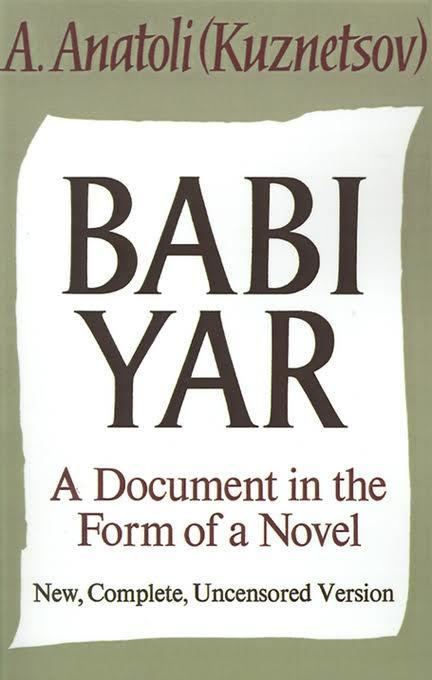8.6 /10 1 Votes8.6
4.3/5 AbeBooks | 4.3/5 Goodreads Originally published 1966 | |||||||||||||||||||||||||||||||||
 | ||||||||||||||||||||||||||||||||||
World War II books A Story About a Real Man, The Kindly Ones, The Diary of a Young Girl, The Hiding Place, The Rise and Fall of the Third | ||||||||||||||||||||||||||||||||||
Babi Yar: A Document in the Form of a Novel (Russian: Бабий яр. Роман-документ) is an internationally acclaimed documentary novel by Anatoly Kuznetsov about the Babi Yar massacre. The two-day murder of 33,771 Jewish civilians on September 29–30, 1941 in the Kiev ravine was one of the largest single mass killings of the Holocaust.
Contents
History
Kuznetsov began writing a memoir of his wartime life in a notebook when he was 14. Over the years he continued working on it, adding documents and eyewitness testimonies.
The novel was first published in 1966 in what Kuznetsov would later describe as a censored form in the Soviet monthly literary magazine Yunost in the original Russian language. The magazine's copy editors cut the book down by[?] a quarter of its original length and introduced additional politically correct material.
In 1969 Kuznetsov defected from the USSR to the UK and managed to smuggle 35-mm photographic film containing the unedited manuscript. The book was published in the West in 1970 under a pseudonym, A. Anatoli. In that edition, the edited Soviet version was put in regular type, the content cut by editors in heavier type and newly added material was in brackets. In the foreword to the edition by the New York-based publishing house Posev, Kuznetsov wrote:
"In the summer of 1969 I escaped from the USSR with photographic films, including films containing the unabridged text of Babi Yar. I am publishing it as my first book free of all political censorship, and I am asking you to consider this edition of Babi Yar as the only authentic text. It contains the text published originally, everything that was expurgated by the censors, and what I wrote after the publication, including the final stylistic polish. Finally, this is what I wrote."
Content
The novel begins as follows:
"Everything in this book is true. When I recounted episodes of this story to different people, they all said I had to write the book. The word ‘document’ in the subtitle of this novel means that I have provided only actual facts and documents without the slightest literary conjecture as to how things could or must have happened."
Kuznetsov describes his own experiences, supplementing them with documents and testimonies of survivors. The tragedy of Babi Yar is shown in the context of German occupation of Kiev from its first days of September 1941 until November 1943. "It is also about the curious fact that a 14-year-old boy can show up anywhere and adults -- German soldiers -- don't especially care. By accident, then, he saw what others were not allowed to see. And by accident, he survived the occupation and lived to write about it." The chapter "How Many Times I Should Have Been Shot" lists 20 reasons the fascists should have shot him according to orders issued by the Nazi occupiers.
When he talks about his own family, the author does not shy away from criticizing the Soviet regime. Several intermissions directly address the future reader.
One of the most often-cited parts of the novel is the story of Dina Pronicheva, an actress of Kiev Puppet Theater. She was one of those ordered to march to the ravine, forced to undress, and then shot. Badly wounded, she played dead in a pile of corpses, and eventually managed to escape. One of the very few survivors of the massacre, she later told her horrifying story to Kuznetsov.
The novel concludes with a warning:
"Let me emphasize again that I have not told about anything exceptional, but only about ordinary things that were part of a system; things that happened just yesterday, historically speaking, when people were exactly as they are today."
